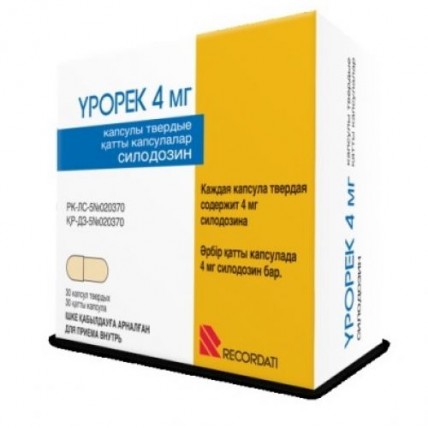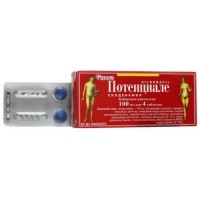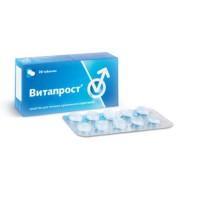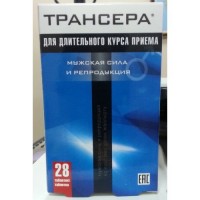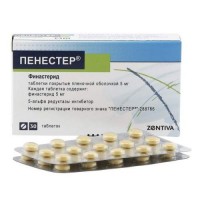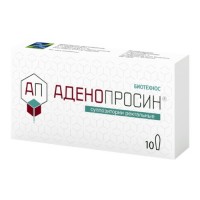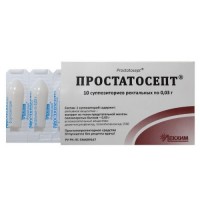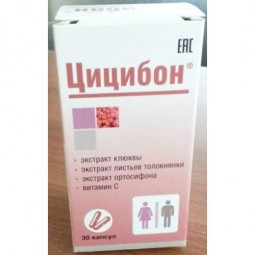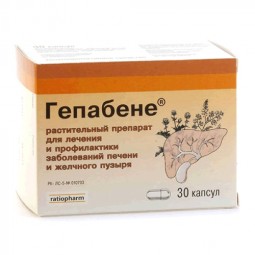Urorek 4 mg capsules solid 30s
- $56.10
Sku:
330fb1909da2
The instruction for medical use of Urorek Torgovoye medicine a name Urorek Mezhdunarodnoye the unlicensed name Silodozin Lekarstvennaya a form solid capsules of 4 mg, 8 mg Structure One tablet contains active agent - silodozin 4.0 mg, 8.0 mg, excipients: Mannitolum, starch prezhelatinizirovany (consists from: starch of prezhelatinizirovanny (corn) (Starch 1500TM) and starch of prezhelatinizirovanny (corn) (PCSTM RS-10)), sodium lauryl sulfate, magnesium stearate, structure of a gelatin capsule for a dosage of 4 mg: gelatin, titan dioxide (E 171), gland (III) oxide yellow (E 172). structure of a gelatin capsule for a dosage of 8 mg: gelatin, titan dioxide (E 171). Description Solid gelatin capsules of yellow color of No. in size 3. Contents of capsules – fine-crystalline powder from white till light yellow color (for a dosage of 4 mg). Solid gelatin capsules of white color of No. in size 0. Contents of capsules – fine-crystalline powder from white till light yellow color (for a dosage of 8 mg). Pharmacotherapeutic group Drugs for treatment of a benign hypertrophy of a prostate. Alpha adrenoblockers. Silodozin. The ATX G04CA04 code the Pharmacological Pharmacokinetics Pharmacokinetics properties of a silodozin and its main metabolites were estimated at adult men with and without benign hyperplasia of a prostate after single and repeated use in doses from 0.1 mg to 48 mg a day. The pharmacokinetics of a silodozin is linear in all range dosed Action of the main metabolite in plasma, a glucuronide of a silodozin (KMD‑3213G), at an equilibrium state is about 3 times more, than effect of initial substance. Silodozin and his glucuronide reach an equilibrium state in 3 and 5 days of treatment, respectively. Absorption Silodozin is well soaked up after oral administration, absorption is proportional to a dose. The absolute bioavailability is about 32%. Food reduces the maximum concentration (Cmax) approximately by 30%, increasing time of achievement of the maximum concentration (tmax) approximately up to 1 h and concentration time (AUC) has the minimum impact on the area under a curve. After oral administration of 8 mg once a day right after a breakfast within 7 days the following pharmacokinetic parameters are noted: Smax-87±51 ng/ml (sd), tmax of 2.5 hours (range 1.0-3.0), AUC - 433±286 ng • h/ml. Distribution the Volume of distribution of a silodozin makes 0.81 l/kg, linking with proteins of plasma makes 96.6%. Silodozin is metabolized by means of a glyukuronirovaniye (with participation of UGT2B7), with participation of alcohol dehydrogenase and aldehyde - dehydrogenases, oxidizing ways, generally with participation of SYRZA4. The main active metabolite in plasma karbamoil-a glucuronide (KMD-3213G) reaches plasma concentration by 4 times bigger, than itself silodozin. Linking of a silodozin of a glucuronide with proteins of plasma makes 91%. Silodozin has no potential of induction or inhibition of isoenzymes of P450 cytochrome. Removal After oral administration 14smarkirovannogo a silodozina, removal of radioactive materials in 7 days was, about 33.5% of a silodozin are removed through kidneys and 54.9% through intestines. The clearance of a silodozin is about 0.28 l/h/kg. Silodozin is excreted generally in the form of metabolites and in very small quantity in not changed view with urine. Final elimination half-life of T1/2 of a silodozin and glucuronide makes 11 hours and 18 hours respectively. Special groups of patients Patients of advanced age Pharmacokinetics of a silodozin and its main metabolites considerably did not change at elderly patients, the clearance of a silodozin does not change at patients 75 years are more senior. Use in pediatrics. Medicine is not recommended to children and teenagers up to 18 years in view of lack of data on safety and efficiency. Liver failure In a research of a single dose of pharmacokinetics of a silodozin did not change at 9 patients with a liver failure of average degree (7-9 on a scale of Chaylda-Pyyu) in comparison with 9 healthy volunteers. By results of this research it is necessary to apply with care as patients had normal biochemical indicators that points to normal metabolic function, and they were referred to category of patients with a liver failure of average degree on the basis of ascites and hepatic encephalopathy. A renal failure In a research of a single dose the action of a silodozin (untied) at patients with easy degree (n=8) and average degree of a renal failure (n=8) led to increase in the maximum concentration by 1.6 times and average concentration of drug in urine by 1.7 times in comparison with patients with normal renal function (n=8). At patients with heavy degree of a renal failure (n=5) the maximum concentration increased by 2.2 times and average concentration of drug in urine - by 3.7 times. Action of the main metabolites, a glucuronide of a silodozin and KMD3293, also amplified. As there are only limited data concerning drug use by patients with a renal failure of average degree (n=35), it is recommended to begin 4 mg with the reduced dose. Patients with a slight renal failure (clearance of creatinine & gt, 50 - & lt, 80 ml/min.) do not require dose adjustment. For patients with a renal failure of moderate severity (clearance of creatinine & gt, 30 & lt, 50 ml/min.) the low initial dose - 4 mg is recommended. For patients with a heavy renal failure (clearance of creatinine & lt, 30 ml/min.) the purpose of a silodozin is not recommended. The pharmacodynamics Silodozin is high-selection for α1A adrenoceptors which are, mainly, in a prostate, a bladder neck, the capsule of a prostate and in a prostatic part of an urethra. Blocking of these α1A adrenoceptors causes relaxation of unstriated muscles of these fabrics that reduces resistance of an exhaust outlet of a bladder, without influencing reduction of unstriated muscles-szhimateley. It causes development of the irritating and obstructive symptoms (symptoms from the lower urinary tract) connected with a benign hyperplasia of a prostate. Silodozin has lower affinity for α1B adrenoceptors which, mainly, are in a cardiovascular system. In the researches in vitro it was shown that the affinity of a silodozin to α1A-адренорецепторам by 162 times exceeds its ability to interact with α1В - adrenoceptors which are located in unstriated muscles of vessels. Clinical performance and safety Over 800 patients with symptoms of a benign hyperplasia of a prostate of average and heavy degree (on the international scale of assessment of prostatic symptoms, initial znacheniye13) accepted silodozin 8 mg in two placebos the controlled clinical trials of stage III conducted in the USA once a day, and in one placebo the controllable and controlled on the operating drug clinical trial conducted in Europe. In all researches of patients which did not react to placebo within 4 weeks of an introduction phase of use of placebo by method of a random sample selected for drug treatment – a research object. In all researches at the patients accepting silodozin the irritating and obstructive symptoms connected with a benign hyperplasia of a prostate in comparison with placebo by estimates in 12 weeks of treatment decreased quicker. Use of 8 mg of a silodozin did not concede in the clinical trial controlled on the operating drug which was conducted in Europe to use of a tamsulozin of 0.4 mg once a day once a day: the average modified difference (95% of CI) in the general ball on IPSS scale between treatment of patients without disturbance of the protocol, was 0.4 (from 0.4 to 1.1). Frequency of affirmative answer on treatment (i.e. improvement of the general point on IPSS scale at least for 25%) was much higher at use of a silodozin (68%) and a tamsulozina (65%), in comparison with placebo (53%). On a long-term open phase of additional treatment of these controlled researches in which patients accepted silodozin till 1 year the relief of symptoms caused silodoziny on the 12th week of treatment was supported during 1 year. On phase IV of clinical trial which was conducted in Europe with average initial general point of IPSS of 18.9 points, 77.1% of patients reacted on silodozin (by estimates of change of a reference value of the general point of IPSS not less, than to 25%). About a half of patients reported about simplification of the majority of symptoms of which patients (i.e. frequent urination, night desires, imperative desires to urination, drop discharge of urine and incomplete devastation of a bladder), by estimates of questionnaires of ICS mail complained. The considerable lowering of arterial pressure in a dorsal decubitus was not observed in all clinical trials which were conducted concerning a silodozin. Silodozin of 8 mg and 24 mg a day had no significant effect on intervals of the ECG or warm repolarization concerning placebo. Blockade α1A - adrenoceptors reduces a tone of smooth muscles in these fabrics that leads to improvement of outflow of urine from a bladder. At the same time the symptoms of obstruction and irritation connected with a benign hyperplasia of a prostate decrease. Thanks to high selectivity silodozin does not cause clinically significant lowering of arterial pressure (ABP) in patients with initially normal ABP. Indications - treatment of signs and symptoms of a benign hyperplasia of a prostate at adult men. The route of administration and doses the Capsule should be accepted at meal time, preferably at the same time day. The capsule should not be crumbled or chewed, the capsule needs to be swallowed entirely, washing down with a glass of water. The recommended dose – on 1 Uroreka capsule of 8 mg a day. For separate categories of patients one Uroreka capsule of 4 mg a day Patients of advanced age is recommended For patients of advanced age the correction of a dose is not required the Renal failure For patients with easy degree of a renal failure (clearance of creatinine ot 50 up to ≤80 ml/min.) correction of a dose is not required. For patients with average degree of a renal failure (clearance of creatinine ot 30 to & lt, 50 ml/min.) it is recommended to begin with a dose 4 mg a day, after one week it is possible to increase a dose to 8 mg a day, depending on reaction of the patient. Use of drug for patients with heavy degree of a renal failure (clearance of creatinine & lt, 30 ml/min.) correction of a dose is not required. The liver failure For patients with easy and average degree of a liver failure correction of a dose is not required. As data are absent, drug use by patients with heavy degree of a liver failure is not recommended. Side effects Safety of a silodozin was estimated in four double blind controlled clinical trials of II‑III of phases (with participation of 931 patients which accepted silodozin 8 mg once a day, and 733 patients who accepted placebo) and in two long-term open researches of the prolonged phase. In general, 1.581 patients accepted silodozin in a dose 8 mg once a day. From them 961 patients took the drug within 6 months and 384 patients – during 1 year. Disturbances of an ejaculation, namely, the return ejaculation and an aneyakulyation (reduction of volume of an ejaculation or its absence), with a frequency of 23% were the most frequent side reactions about which it was reported in placebo controlled clinical trials at long-term use of a silidozin. It can temporarily affect ability to conceive. Such disturbances disappear in several days after the treatment termination. The undesirable side reactions noted in all clinical trials and throughout the international post-marketing experience of use concerning which there is relationship of cause and effect, according to classification of MedDRA according to defeat of bodies and the systems of bodies and development frequency are listed below: very often (≥1/10), it is frequent (≥1/100 to & lt, 1/10), infrequently (≥1/1.000 to & lt, 1/100), is rare (≥1/10.000 to & lt, 1/1.000), is very rare (& lt, 1/10.000), it is not known (it is impossible to estimate on the available data). In each group the observed side reactions are provided as decrease in degree of gravity. Very often - disturbances of an ejaculation, including the return ejaculation and an anaekulyation Often - dizziness, orthostatic hypotension - congestion of a nose, - diarrhea Infrequently - decrease in a libido - takhikardiya1 - gipotenziya1 - nausea, dryness in a mouth - abnormal hepatic proby1 - skin syp1, zud1, krapivnitsa1, medicinal syp1 - erectile dysfunction Seldom - a syncope, loss soznaniya1 - speeded up pulsatsiya1 Is very rare - allergic reactions, including puffiness of the person, the ingestion of language and hypostasis glotki1 is not known - an intraoperative syndrome of a flabby iris 1 – side reactions according to voluntary reports in the course of the international post-registration use of drug (frequency was calculated in the cases described in clinical trials of phase I-IV and in not intervention researches). The description of separate side reactions Orthostatic hypotension the Frequency of developing of orthostatic hypotension in placebo controlled clinical trials was 1.2% at use of a silodozin and 1.0% at placebo use. Orthostatic hypotension sometimes led to faints. An intraoperative syndrome of a flabby iris (IFIS) About IFIS it was reported by results of surgeries concerning a cataract. Reports on the suspected side reactions the Message about the suspected side reactions after registration of medication is very important. It allows to continue to control a ratio advantage/risk of medication of the Contraindication - hypersensitivity to active ingredient or to any excipient - orthostatic hypotension in the anamnesis - a liver failure - children's age up to 18 years - a renal failure (clearance of creatinine less than 10 ml/min.) Medicinal interactions Silodozin is actively metabolized, especially through CYP3A4, an alkogoldegidraza and UGT2B7. Silodozin is also substrate for a P-glycoprotein. Substances which suppress (for example, ketokonazol, itrakonazol, ritonavir or cyclosporine) or cause emergence (for example, rifampicin, barbiturates, carbamazepine, Phenytoinum) such enzymes and conveyors, can affect concentration of a silodozin and its active metabolite in plasma. Alpha blockers the Relevant information on safe use of a silodozin together with other antagonists α ‑ there are no adrenoceptors. Therefore, simultaneous use of other antagonists α ‑ adrenoceptors is not recommended. CYP3A4 B inhibitors a research of medicinal interaction, at simultaneous use of a silodozin and highly active CYP3A4 inhibitor (ketokonazola of 400 mg) the increase in the maximum concentration of a silodozin in plasma by 3.7 times and increase in time of influence of a silodozin by 3.1 times was observed (average concentration in urine). Simultaneous use of highly active CYP3A4 inhibitors is not recommended (for example, a ketokonazola, an itrakonazola, a ritonavir or cyclosporine). At simultaneous use of a silodozin and CYP3A4 inhibitor of an average degree of activity, for example, of diltiazem, increase in average concentration of a silodozin in urine approximately for 30% was observed, however the maximum concentration and a half-life period did not change. This change has no clinical value therefore correction of a dose is not required. PDE‑5 inhibitors the Minimum pharmakodinamichesky interactions were observed between silodoziny and the maximum doses of a sildenafil or tadalafit. In placebo a controlled research on 24 subjects at the age of 45-78 years who received silodozin the simultaneous use of a sildenafil of 100 mg or a tadalafil of 20 mg did not cause clinically significant reduction of average systolic or diastolic blood pressure by estimates of orthostatic researches (standing and lying). At subjects 65 years are more senior, average reduction in various points of time was between 5 and 15 mm Hg. (systolic) and between 0 and 10 mm Hg. (diastoliches
oho). Positive orthostatic tests were only a little more frequent during simultaneous use of medicines, however, dizziness or other symptoms were not observed. The condition of the patients accepting PDE‑5 inhibitors along with silodoziny has to be controlled regarding possible side reactions. Hypotensive drugs In the program of clinical trial many patients at the same time took the hypotensive drugs (most of them affected renin-angiotenzinovuyu a system, beta-blockers, antagonists of calcium and diuretics) without increase in frequency of orthostatic hypotension. Nevertheless, it is recommended to show care at simultaneous use of drug with hypotensive drugs and to control a condition of patients regarding possible side reactions. Digoxin Equilibrium levels of digoxin, substrate Rglikoproteina, considerably did not change as a result of simultaneous use of a silodozin of 8 mg once a day. Correction of a dose was not required. Special instructions the Intraoperative syndrome of a flabby iris (IFIS) of IFIS (kind of a syndrome of a narrow pupil) was observed during surgery on removal of a cataract at some patients who are accepting α1‑блокаторы or earlier accepting α1‑блокаторы. It can complicate similar operations. It is not recommended to begin treatment silodoziny for patients to whom it is going to perform surgery concerning a cataract. It is recommended to stop treatment α1‑блокаторами in 1-2 weeks prior to surgery, however, advantages and duration of the termination of treatment before surgery concerning a cataract are not established. During assessment before carrying out surgery the surgeons-ophthalmologists and other experts in ophthalmology have to consider whether patients to whom surgery concerning a cataract is necessary accept, silodozin to provide acceptance of the appropriate measures concerning IFIS during operation. Orthostatic action Frequency of orthostatic action of a silodozin very low. However some patients can have a lowering of blood pressure that in rare instances leads to faints. At the first symptoms of orthostatic hypotension (for example, postural dizziness), the patient should sit down or lay down and to remain in such situation until symptoms do not disappear. Treatment silodoziny is not recommended to patients with orthostatic hypotension. The renal failure treatment silodoziny is not recommended to Patients with a heavy renal failure (CLCR & lt, 30 ml/min.). A liver failure As data concerning drug use by patients with heavy degree of a liver failure are absent, use of a silodozin by such patients is not recommended. A prostate cancer As at DGPZh and a prostate cancer identical symptoms, and they can coexist, patients at whom DGPZh is suspected have to undergo inspection prior to treatment silodoziny to exclude a prostate cancer. The manual rectal research and if it is necessary, definition of prostatic specific antigen (PSA) has to be executed before an initiation of treatment, and has to repeat regularly after that. Treatment silodoziny leads to reduction of amount of sperm during an orgasm that can temporarily affect fertilizing capacity of sperm. Such action stops after phase-out of a silodozin. Pregnancy and breastfeeding Silodozin is intended only for men. The fertility In clinical trials at use of a silodozin was observed an ejaculation with the lowered amount of sperm or without sperm because of pharmakodinamichesky features of a silodozin. Before an initiation of treatment of the patient it is necessary to inform that it can occur, and that drug affects fertilizing capacity of sperm. Features of influence of medicine on ability to run the vehicle or potentially dangerous Urorek mechanisms in insignificant or in average degree can affect ability to run vehicles and mechanisms. Patients need to be informed on the possible symptoms connected with postural hypotension (dizziness) and that they have to be careful in control of vehicles and mechanisms. Overdose Symptoms: heavy arterial hypotension. Treatment: Use of a silodozin in doses up to 48 mg/days was estimated at healthy men. Postural hypotension was the side reaction limiting a dose. If administration of drug happened recently, gastric lavage will be effective. If the overdose of a silodozin led to hypotension, it is necessary to carry out cardiopulmonary resuscitation. Dialysis, it is improbable, will be effective as silodozin highly (96.6%) contacts proteins. The form of release and packing On 10 capsules place in blister strip packaging from an opaque film of PVH/PVDH and aluminum foil. On 1, 3 or 5 blister strip packagings together with the instruction for medical use in the state and Russian languages place in a pack from cardboard. To Store storage conditions in the dry, protected from light place, at a temperature not over 30 of 0C, in original packing. To store out of children's reach. 3 years not to apply a period of storage after an expiration date. Prescription status According to the prescription the Producer Recordati Industria Chimica e Farmaceutica S.P.A. Via M. Civitali 1, 20148, Milan, Italy / Via M. Chivitali 1, 20148, Milan, Italy Owner of the registration certificate Recordati Ireland Ltd. Raheens East Ringaskiddy, Co. Cork, Ireland / Rakhins East, Ringaskiddi, To. Cork, Ireland the Address of the organization accepting in the territory of the Republic of Kazakhstan claims from consumers on quality of products Representative office of FIC MEDICAL LLP (FICK MJEDIKAL) in Republic of Kazakhstan, Tolya St. bi 69 office 33, 050000, Almaty, Kazakhstan
to Develop
oho). Positive orthostatic tests were only a little more frequent during simultaneous use of medicines, however, dizziness or other symptoms were not observed. The condition of the patients accepting PDE‑5 inhibitors along with silodoziny has to be controlled regarding possible side reactions. Hypotensive drugs In the program of clinical trial many patients at the same time took the hypotensive drugs (most of them affected renin-angiotenzinovuyu a system, beta-blockers, antagonists of calcium and diuretics) without increase in frequency of orthostatic hypotension. Nevertheless, it is recommended to show care at simultaneous use of drug with hypotensive drugs and to control a condition of patients regarding possible side reactions. Digoxin Equilibrium levels of digoxin, substrate Rglikoproteina, considerably did not change as a result of simultaneous use of a silodozin of 8 mg once a day. Correction of a dose was not required. Special instructions the Intraoperative syndrome of a flabby iris (IFIS) of IFIS (kind of a syndrome of a narrow pupil) was observed during surgery on removal of a cataract at some patients who are accepting α1‑блокаторы or earlier accepting α1‑блокаторы. It can complicate similar operations. It is not recommended to begin treatment silodoziny for patients to whom it is going to perform surgery concerning a cataract. It is recommended to stop treatment α1‑блокаторами in 1-2 weeks prior to surgery, however, advantages and duration of the termination of treatment before surgery concerning a cataract are not established. During assessment before carrying out surgery the surgeons-ophthalmologists and other experts in ophthalmology have to consider whether patients to whom surgery concerning a cataract is necessary accept, silodozin to provide acceptance of the appropriate measures concerning IFIS during operation. Orthostatic action Frequency of orthostatic action of a silodozin very low. However some patients can have a lowering of blood pressure that in rare instances leads to faints. At the first symptoms of orthostatic hypotension (for example, postural dizziness), the patient should sit down or lay down and to remain in such situation until symptoms do not disappear. Treatment silodoziny is not recommended to patients with orthostatic hypotension. The renal failure treatment silodoziny is not recommended to Patients with a heavy renal failure (CLCR & lt, 30 ml/min.). A liver failure As data concerning drug use by patients with heavy degree of a liver failure are absent, use of a silodozin by such patients is not recommended. A prostate cancer As at DGPZh and a prostate cancer identical symptoms, and they can coexist, patients at whom DGPZh is suspected have to undergo inspection prior to treatment silodoziny to exclude a prostate cancer. The manual rectal research and if it is necessary, definition of prostatic specific antigen (PSA) has to be executed before an initiation of treatment, and has to repeat regularly after that. Treatment silodoziny leads to reduction of amount of sperm during an orgasm that can temporarily affect fertilizing capacity of sperm. Such action stops after phase-out of a silodozin. Pregnancy and breastfeeding Silodozin is intended only for men. The fertility In clinical trials at use of a silodozin was observed an ejaculation with the lowered amount of sperm or without sperm because of pharmakodinamichesky features of a silodozin. Before an initiation of treatment of the patient it is necessary to inform that it can occur, and that drug affects fertilizing capacity of sperm. Features of influence of medicine on ability to run the vehicle or potentially dangerous Urorek mechanisms in insignificant or in average degree can affect ability to run vehicles and mechanisms. Patients need to be informed on the possible symptoms connected with postural hypotension (dizziness) and that they have to be careful in control of vehicles and mechanisms. Overdose Symptoms: heavy arterial hypotension. Treatment: Use of a silodozin in doses up to 48 mg/days was estimated at healthy men. Postural hypotension was the side reaction limiting a dose. If administration of drug happened recently, gastric lavage will be effective. If the overdose of a silodozin led to hypotension, it is necessary to carry out cardiopulmonary resuscitation. Dialysis, it is improbable, will be effective as silodozin highly (96.6%) contacts proteins. The form of release and packing On 10 capsules place in blister strip packaging from an opaque film of PVH/PVDH and aluminum foil. On 1, 3 or 5 blister strip packagings together with the instruction for medical use in the state and Russian languages place in a pack from cardboard. To Store storage conditions in the dry, protected from light place, at a temperature not over 30 of 0C, in original packing. To store out of children's reach. 3 years not to apply a period of storage after an expiration date. Prescription status According to the prescription the Producer Recordati Industria Chimica e Farmaceutica S.P.A. Via M. Civitali 1, 20148, Milan, Italy / Via M. Chivitali 1, 20148, Milan, Italy Owner of the registration certificate Recordati Ireland Ltd. Raheens East Ringaskiddy, Co. Cork, Ireland / Rakhins East, Ringaskiddi, To. Cork, Ireland the Address of the organization accepting in the territory of the Republic of Kazakhstan claims from consumers on quality of products Representative office of FIC MEDICAL LLP (FICK MJEDIKAL) in Republic of Kazakhstan, Tolya St. bi 69 office 33, 050000, Almaty, Kazakhstan
to Develop
